More about Self-portrait at Thirteen
- All
- Info
- Shop

Sr. Contributor
Unlike most of us, Albrecht Dürer wanted to remember the way he looked during puberty and created Self-Portrait at Thirteen to masterfully record his adolescent likeness.
Puberty is rough. It is the unavoidable awkward phase of every person’s life marked by zits, bad hair cuts, and questionable wardrobe choices. Apparently, Albrecht Dürer never got the memo that puberty is all about insecurities and instead oozed self-confidence, talent, and poise at the tender age of thirteen. In 1484, the thirteen-year-old Dürer was the newest apprentice at his father’s renowned goldsmith workshop. While shadowing his father, Dürer gained immense experience in designing and modelling metal jewelry, silverware, and decorative pieces. But, arguably the greatest outcome of the apprenticeship was Dürer’s introduction to metalpoint drawing.
Metalpoint is a graphic technique where the artist draws with a metal stylus commonly made of silver, gold, copper, or brass. When pressed to a prepared abrasive surface, the stylus leaves behind small particles of metal to make a mark. Craftsmen like Dürer’s father used metalpoint to sketch and plan designs for their pieces. Metal styluses and metalpoint paper were prevalent in his father’s workshop, so it is no wonder that during a slow day, Dürer might have picked up a stylus and tried his hand at metalpoint.
The result of Durer’s virgin voyage into metalpoint was Self-Portrait at the Age of Thirteen. The piece is Dürer’s earliest surviving artwork as well as the earliest known portrait made by a child artist. At thirteen, Dürer was already more talented than most, yet he still had room to improve, as is demonstrated by his difficulty drawing drapery and human proportions (that is a freakishly tiny wrist!). Nonetheless, Self-Portrait at Thirteen held a special place in Dürer’s heart, and he kept the piece with him for many years. Sometime later in his career, Dürer added an inscription to the childhood portrait that reads “I drew this after myself from a mirror in the year 1484 when I was still a child.” This note solidifies in the minds of all who look at Self-Portrait at Thirteen that Dürer was a skillful artist at an age when the rest of us were barely surviving middle school.
After Self-Portrait at Thirteen, Dürer worked under his father for two more years before starting an apprenticeship with painter Michael Wolgemut. From that moment on, Dürer’s career as a portraitist, engraver, and religious painter took off. Throughout his lifetime, Dürer frequently returned to the medium of his youth and created over 80 metalpoint drawings. Today, Dürer is known as one of the most prominent metalpoint artists from the Renaissance.
Sources
- “Albrecht Dürer: Master Drawings, Watercolors, and Prints from the Albertina.” National Gallery of Art. Accessed May 21, 2021. https://www.nga.gov/features/slideshows/albrecht-duerer--master-drawing…- -and-prints-from-t.html#slide_1.
- Chapman, Hugo. “Silver Linings: The Art of Metalpoint Drawing.” Apollo Magazine (2015). https://www.apollo-magazine.com/silver-linings-the-art-of-metalpoint-dr….
- Heaton, Charles. The Life of Albrecht Dürer of Nürnberg. London: Seely, Jackson and Halliday, 1881.
- Morris, Roderick C. “The Enduring Appeal of Metalpoint.” The New York Times (2015). https://www.nytimes.com/2015/10/22/arts/international/the-enduring-appe… t.html.
- “Self-portrait as a thirteen-year-old.” ALBERTINA online. Last modified March 29, 2021. https://sammlungenonline.albertina.at/?query=Inventarnummer=(4839)&show… d#/query/4e6572f6-30a1-4a30-aa35-64874c503175.
Featured Content
Here is what Wikipedia says about Self-Portrait at the Age of 13

Self-Portrait at the age of 13 (the title is modern) is a silverpoint drawing by Albrecht Dürer, dated 1484, when the artist was either twelve or thirteen years of age. It is now in the Albertina museum, Vienna, where it arrived, via the collections of the Imhoff family in Nuremberg and the Habsburg collections, from Dürer's own literary and remains. It is the artist's oldest known surviving drawing, one of the oldest extant self-portraits in European art, and one of the earliest child's drawings, as well. It was completed two years before Albrecht left his father's apprenticeship to study under Michael Wolgemut, whom (some modern authors speculate) he quickly realised was a valuable mentor but whom the younger man may have recognized was unequal to himself in his abilities.
Throughout his life Dürer expressed resolute self-confidence. He celebrated himself in his drawings and writings. His four known self-portraits were all completed before he entered his 30s, and so they predate his mature period. As with the other three self-portraits, which are oil paintings, this work can be interpreted as having recorded Dürer's awareness of, and confidence in, his great-yet-still-developing artistic powers. This tone is especially evident in the subject's precocious countenance. Dürer presents himself in half-length and in side view, in a pose closely resembling the one seen in a surviving portrait attributed to his father, also Albrecht, who was a goldsmith by profession. That both drawings are self-portraits is indicated by their treatment of the right hand, which appears hidden, because difficult to capture while in the act of drawing.
The artist's left arm is raised, while his index finger, boldly points to an unidentified area outside the picture’s frame. Dürer presents himself in a flattering light: He has long hair, he has the pleasing appearance of a fresh-faced boy, and he has elegant and elongated fingers (at the time, this was a characteristic both fashionable and seen to indicate draftsman skills). Dürer wrote in the 1520s that even his simple sketches expressed "the spiritual essence of an artist's creative impulse"—since a talented artist could express more in a simple line-drawing than a mediocre artist could express in a year of painting. By the time he made this statement, the artist was looking back at his production, including early works like the silverpoint self-portrait that had been made before he entered formal training as an artist under Wolgemut. From this retrospective point of view, the drawing becomes proof of Dürer's inborn genius, though at the time of its creation it had a quite different purpose. That it was preserved, however, proves that Dürer's family, most likely his father, saw fit to collect his son's output.
It has been speculated on the basis of Dürer's Family Chronicle that the self-portrait might have been set as a task by Albrecht the Elder as a challenge for his son. It was signed at some unknown later date (probably in the 1520s) with the words "This I drew myself from a mirror in the year 1484, when I was still a child. Albrecht Dürer". Dürer was born in May 1471, and he himself did not title the work--nor did he title most of his works; given that it was completed in 1484, it is almost equally likely Dürer had created it when he was 12 years old, even though the self-portrait is sometimes known by the invented title "at the age of 13"
Check out the full Wikipedia article about Self-Portrait at the Age of 13

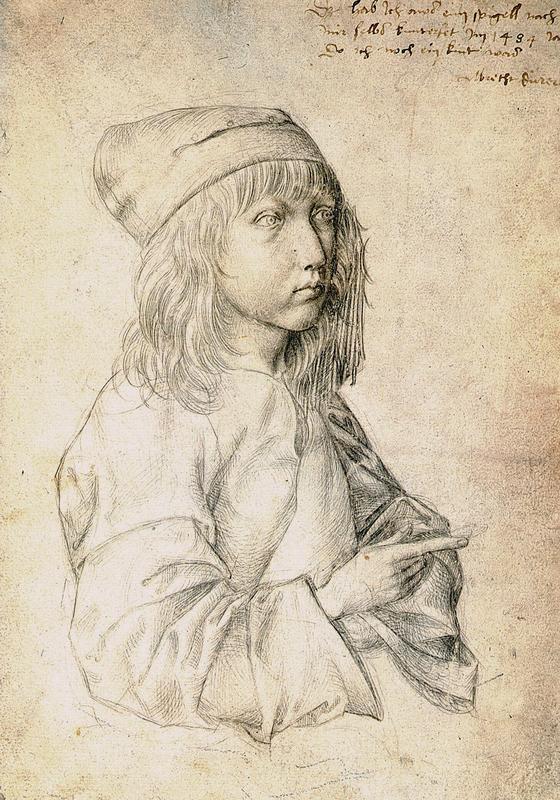
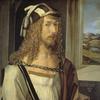

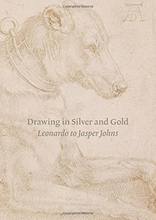
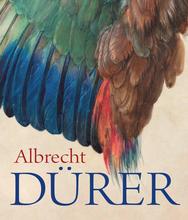









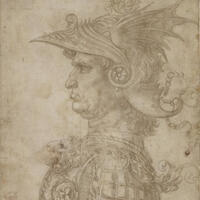
I find this artwork impressive because of the intentionality of the shading lines. For a thirteen year old using a medium that does not allow for mistakes the shading seems very clean. The spacing between lines in the same area of shading is fairly even at all times. Duerer also managed to work this shading into the wavy shape of his hair.